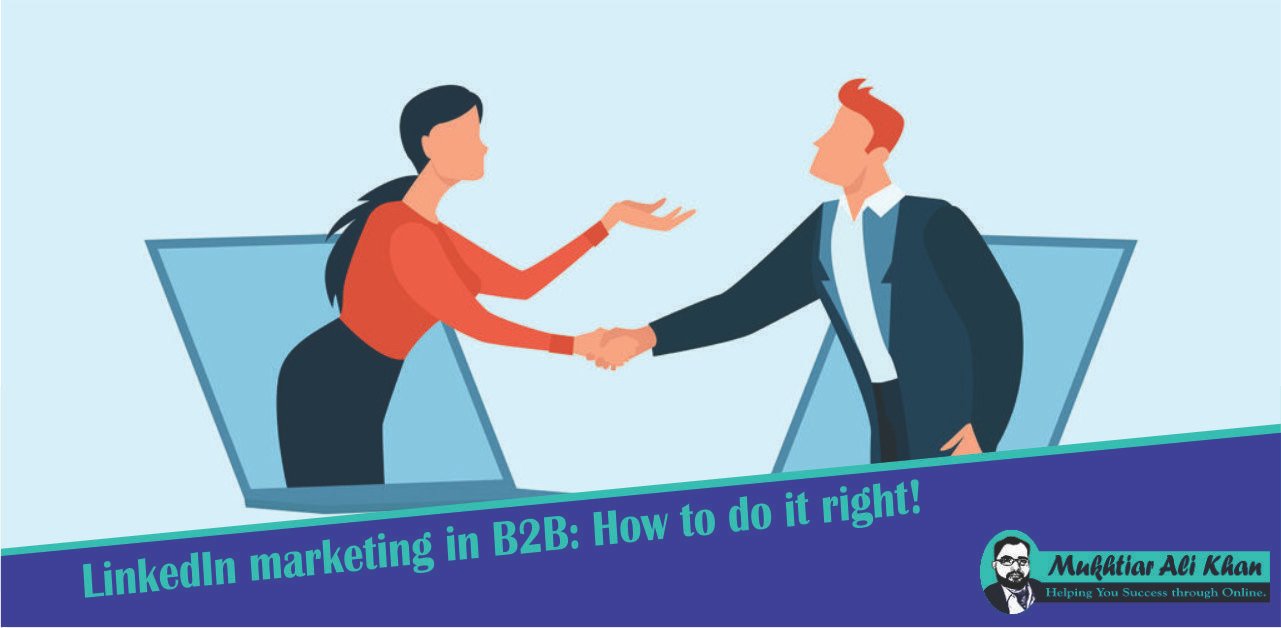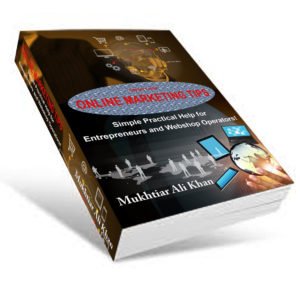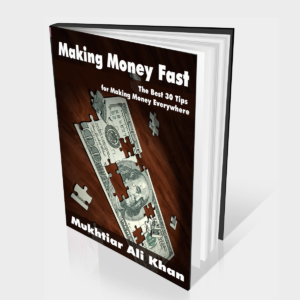Discover the secrets of successful LinkedIn marketing in the B2B space. Boost your brand visibility, connect with industry professionals, and generate valuable leads. At least since LinkedIn posts have also appeared in Google search results – i.e. are SEO-relevant – it has been clear: every B2B company should use LinkedIn marketing. This post provides best practices to get you started.

- Why LinkedIn Marketing?
- First step: create a profile
- Best practices for posting on LinkedIn
- Understand the Algorithm: Quality First in LinkedIn Marketing
- Content Marketing on LinkedIn: What Should You Post?
- The perfect post on LinkedIn
- Best practices for LinkedIn marketing with advertising
- Basic Tips for Successful LinkedIn Ads
- Thinking is worth it!
Why LinkedIn Marketing?
LinkedIn is the world’s largest professional social network. Even if the pure user numbers are still just behind those of XING, it is also becoming more and more important. LinkedIn has long since ceased to be used solely for networking and job hunting.
With detailed posts, users stand out as experts in their field or position themselves as opinion leaders on currently relevant topics. Often there is a lot of hot air, empty phrases, exaggerated stories, and enormous copy-paste talent behind it.
Done right, LinkedIn marketing puts your company directly in the field of vision of your desired customers – especially that of decision-makers. In contrast to XING, it is mostly specialists and executives who register on LinkedIn.
Since LinkedIn posts are also recorded by Google and presented in the search results, LinkedIn marketing also increases your general reach on the Internet. So a win-win situation. The only question now is: How do you do LinkedIn marketing correctly?
First step: create a profile
You can do LinkedIn marketing via a private profile as well as via a company profile. Both have their advantages.
With a company page, you create a profile for your company on LinkedIn – it supports the branding, the branding of your company. In addition, several people can look after the company website with their account, provided they have administrator access.
If, on the other hand, you want to implement LinkedIn marketing via a private account, everyone responsible (employees, but also agencies) would have to log in with their password. On the other hand, private profiles are usually more relevant for LinkedIn itself, but also for the users, and achieve more reach.
Unlock the power of successful LinkedIn marketing in the B2B space, understanding the nuances of Marketing vs. branding. Learn how to optimize your profile, create engaging content, and leverage LinkedIn’s networking capabilities to reach your target audience. Stay ahead of the competition and establish your brand as a thought leader in the industry.
Best practices for posting on LinkedIn
Important to know: Like marketing on any other social network, LinkedIn marketing is made up of two blocks. On the one hand, there is the content – i.e. posts that you ideally publish regularly. On the other hand, there are paid advertisements. Let’s look at the content first.
Understand the Algorithm: Quality First in LinkedIn Marketing
No social network wants to alienate its users. From YouTube to Instagram, everyone, therefore, relies on their algorithm to assess the relevance of the published content. LinkedIn is no exception – except perhaps in the sense that its algorithm is particularly strict, but also particularly transparent. Every post goes through a four-stage control cycle, which you should know for successful LinkedIn marketing.
- Spam check: Immediately after publishing, a bot checks the post and rates it as “spam”, “low quality” or “approved”. Of course, spam is thrown out immediately and does not even appear in the feed.
- Test run: If the post passes the spam check, LinkedIn plays it to a sample of your network and checks the engagement. This includes likes, comments, and shares. Comments are particularly important – but you should respond to them as quickly as possible. The more engagement your post gets within the first hour of publication, the more relevant it is to the algorithm. For insights into how your post is performing, click View Analytics below the post.
- Virality check: If your post gets a lot of attention, take a closer look at the LinkedIn creator and content. Who exactly published that? How credible is this person or company? And how relevant is the content for the target group it is intended to reach? Incidentally, the algorithm also supports you here with a small boost if your post is relevant but hardly gets any reactions.
- Review by an editor: This is where a human employee comes into play. If your contribution is particularly successful, an editor will take another look and assess the quality. After that, the review starts again from level 2 – and this cycle continues as long as your contribution is in circulation.
Read Also: B2B Vs B2C Marketing: 7 Critical Differences You Must Know
Content Marketing on LinkedIn: What Should You Post?
As a career network, LinkedIn is all about business, finance, success, and mindset. Dog videos, crochet instructions, and cooking recipes have no place here. To find the right topics for your posts, you should put yourself in the shoes of your target audience.
What interests decision-makers in your industry? What topics are trending right now? Where do problems frequently arise, and what exciting innovations have emerged?
By answering these questions, you can find genuinely relevant topics. Using content marketing tools, you can tailor your posts to be even more impactful, ensuring that the more relevant a post is, the more successful it will be.
There are two options for LinkedIn marketing via content:
- A “normal” LinkedIn post: These are the posts that appear normally in the feed. They are limited in length and are suitable for dealing with a topic in a compact manner or expressing your own opinion. We’ll go into more detail about this type of content in a moment.
- LinkedIn Pulse article: With Pulse, LinkedIn has launched its publishing platform. Here you can publish particularly detailed articles and thus position yourself more strongly as an expert. The downside: Pulse articles have less reach than a regular post
The perfect post on LinkedIn
It feels like every LinkedIn expert has other tips on what the perfect post looks like to drive LinkedIn marketing via content. However, the experts agree on these to-dos for a lot of commitment and reach:
- The first three lines of your post are always visible. They should entice them to click “show more.”
- Write your posts in a length of about 1,300 characters.
- Use three to five relevant, thematically appropriate hashtags (#). More or fewer hashtags reduce reach. One of them can be your hashtag to build a brand on LinkedIn – e.g. #contentmarketingstar. People outside of your network will also find your post through hashtags.
- Use a maximum of ten emojis in your posts – preferably as bullet points.
- Only set one link – and preferably in the post itself. LinkedIn doesn’t like it when you link to external sites. That’s why there used to be a tip to post links as a comment field yourself. According to experience, however, this reduces your reach enormously, so that the link directly in the article is the lesser evil.
- A combination of text and image (in a square format) is more successful than text-only posts. People just like looking at pictures.
- Incidentally, even more, successful are text contributions in combination with several pdf pages as a “slide deck” – through which users have to click through to read the entire content.
- Post regularly, preferably between 10 am and 12 pm.
- Stay authentic.
Read Also: How to use hashtags to improve your social media marketing
Best practices for LinkedIn marketing with advertising
Posts are one thing. But you get more reach and thus more attention to your company if you also place LinkedIn Ads. LinkedIn allows you to be very selective about who should see your ads. In this way, you reduce wastage and primarily address users who might be interested in your topics.
For LinkedIn marketing via ads, we recommend a two-stage campaign.
Stage 1: Engagement Campaign
First, run an engagement campaign that leads to an interesting post on your blog, for example. However, you can also introduce an employee of your company and ask users to the network. Background: Most people on LinkedIn need to “warm up” before you can turn them into leads. Only a few would directly book a consultation or buy a product.
With an engagement campaign, you deliver added value without demanding anything binding in return. The engagement phase of LinkedIn Ads marketing should last at least two weeks.
Our tip: build the campaign with targeted ads, but also add posts from your feed now and then. However, these contributions may not exceed a text length of 150 characters.
Stage 2: Conversion or Lead Gen campaign
Ideally, potential prospects have already come across your advertisements two or three times. They know the name of your company. Interested parties know which topics are your focus.
With a lead gen campaign or conversion campaign lasting at least two weeks, you can now prompt the viewers of your ads to take a specific action. This can be an appointment for a consultation, but also the download of a lead magnet in exchange for the e-mail address.
In this way, you increase the number of leads or conversions achieved, but at the same time reduce the costs per lead/conversion.
Basic Tips for Successful LinkedIn Ads
- The same applies here: there must be added value – put blatant product advertising and self-congratulation in the dustbin! When it comes to LinkedIn marketing always focuses on the “why,” not the “what.”
- Get the text of your ads to the point.
- Begin the texts with a question (caution: no rhetorical run-of-the-mill question) or a striking statement.
- Describe a problem or solution in the first part of your ad copy. Include interesting numbers or facts. Discuss your wishes and goals. A call to action follows.
- Upload ad images in a square format and use colors that contrast with LinkedIn’s gray, white, and blue color scheme.
Thinking is worth it!
At its core, LinkedIn marketing isn’t all that different from marketing on other social media platforms. As always, marketing based on value is more successful than a feed full of ads. So always keep in mind the added value your posts or your ads offer to interested parties. Do you provide advice? Do they point to instructions? Do they invite you to expand your professional network?
Delivering value is half the battle. Now it’s just a matter of learning about the idiosyncrasies of LinkedIn marketing. It takes time, but it’s hugely worth it to reach the decision-makers of the desired customers and at the same time expand your reach. One final tip: don’t forget to join groups and respond to your network’s posts, too!
We wish you every success with this project – and are happy to be there for you if you need support.





